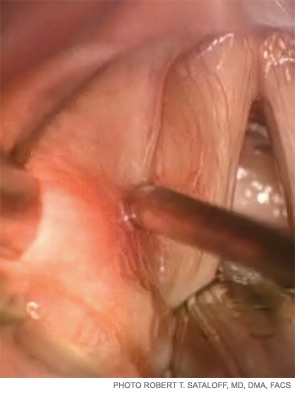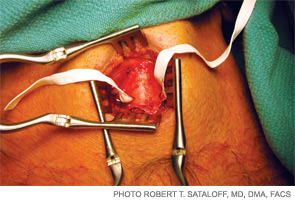People get face-lifts and other types of cosmetic surgery to look better. They exercise so that they’ll feel better. But few people consider a voice lift, which combines surgery and exercise to make them sound better.
Explore This Issue
April 2010“People spend thousands of dollars on chin implants, rhinoplasties, face-lifts, body sculpting, and then they open their mouth and everyone knows instantly they’re 80 years old,” said Robert T. Sataloff, MD, DMA, FACS, who invented the term “voice lift” during an interview with a reporter several years ago. “This is not necessary,” said Dr. Sataloff, professor and chairman of the Department of Otolaryngology—Head and Neck Surgery, and senior associate dean for Clinical Academic Specialties at the Drexel University College of Medicine in Philadelphia. “The vocal characteristics that cue people to advanced age are subject to alteration.”

But should vanity be the motivation for a voice lift? Many laryngologists dislike the term itself because it makes the exercises and surgical procedures involved sound cosmetic rather than therapeutic.
“Vocal fold microsurgery is not to be viewed as rejuvenation,” said Robert W. Bastian, MD, founder of the Bastian Voice Institute in Downers Grove, Ill. “Instead it should be seen as an attempt to return to original capabilities that have been diminished by an injury or lesion. You’re not rejuvenating because of aging or the passage of time.”
Yet, the term “voice lift” has caught on among laryngologists, who agree that the procedures involved are becoming more common, although no numbers are available. “There weren’t as many older individuals 50 or 60 years ago, so the aging voice wasn’t much of a concern,” said Michael M. Johns, MD, director of the Emory Voice Center at Emory University Hospital Midtown in Atlanta. “It’s going to be a growing problem, given that the baby boomers have entered retirement age.”
Treatment
The voice lift does not necessarily mean surgery. Most of what is known as a voice lift can be achieved through exercise alone, according to Dr. Sataloff. “At least 75 to 80 percent of people looking for improvement can achieve their goals through voice therapy and rehabilitation,” he said. “One reason I wish I hadn’t invented the term ‘voice lift’ is that it makes people think they can get a quick operation and go home. It doesn’t work that way.”
The voice lift begins with a thorough exam to rule out other health problems. Laryngeal pathology, including laryngopharyngeal reflux disease (LPR), nodules and polyps, must be excluded. Emphysema and other lung problems that can reduce the airflow needed to produce sound also need to be considered.
 People spend thousands of dollars on chin implants, rhinoplasties, face-lifts, body sculpting and then they open their mouth and everyone knows instantly they’re 80 years old.
People spend thousands of dollars on chin implants, rhinoplasties, face-lifts, body sculpting and then they open their mouth and everyone knows instantly they’re 80 years old.—Robert T. Sataloff, MD, DMA, FACS
Treatments for other health problems may affect the voice, too. “Medications for high blood pressure, depression and other disorders can affect the voice,” Dr. Sataloff said. “Many meds can cause drying, tremor, loss of concentration and other side effects that may impair phonation.”
Once health problems are discovered and addressed, patients begin vocal therapy, which involves aerobic exercise to increase lung capacity and voice training to strengthen the vocal folds.
As a person’s vocal folds age and the intrinsic laryngeal muscles atrophy, the folds may no longer close tightly, allowing air to escape and creating a breathy voice. The person develops presbyphonia, characterized by hoarseness, reduced loudness, increased breathiness, strain and tremor. Filler injections can temporarily add mass to the vocal folds, while autogenous adipose tissue injections can produce a permanent increase in density. If the vocal folds need more bulk, tiny shims made out of Gore-Tex or Silastic can be implanted.
“We make an incision in a skin crease over the lower part of the larynx and make a small hole in the laryngeal cartilage through which we place the shims,” Dr. Sataloff said. “This brings the vocal folds closer to the midline, so, instead of a gap, the patient has good, firm vocal fold contact, and hence a strong voice with low effort.”

Growing Popularity
While some laryngologists are uncomfortable with the idea of improving the voice strictly to enhance its sound, the voice lift as a cosmetic procedure seems to be gaining in popularity. In 2006, an episode of “Nip/Tuck,” a series on cable channel FX about cosmetic surgeons, featured Kathleen Turner as a phone-sex worker who wanted to make her voice, ravaged by years of scotch and cigarettes, sound younger. And various Web sites tout the voice lift as a way to sound as young as cosmetic surgery can make you look.
Dr. Sataloff points out that, whether we like it or not, the voice contributes significantly to the overall impression a person makes. “People have a natural tendency to infer that someone with an infirm, unsteady voice has an infirm, unsteady mind,” he said.
Voice problems can also degrade quality of life, according to recent research. “We looked at associations in the elderly population between hearing loss and voice problems,” said Seth Cohen, MD, MPH, an assistant professor of Otolaryngology-Head and Neck Surgery at Duke University Medical Center Department of Surgery and a laryngologist in the Duke Voice Care Center in Durham, N.C. “Our research doesn’t prove that hearing loss causes voice problems, but it shows that the odds of having voice problems are increased if you have hearing loss. Those with both hearing loss and voice problems had greater depression symptom scores than those who had neither.” (The Laryngoscope. 2009;119(9):1870-1873.)
As voice problems become more widespread with increased longevity, treatments are likely to become more effective, according to Dr. Johns. “If we could rejuvenate tissue through biomanipulation, we would have treatment options that could advance the possibilities for presbyphonia,” he said. “And these options may not be as far off as it seems. There are outstanding researchers looking for ways to deliver growth factors and stem cells to rejuvenate aging vocal fold tissue.”
The elements that go into the voice lift evolved in large part from the treatment of singers who had strained their voices in some way. “The problems of singers are merely exaggerations of problems everyone can have,” Dr. Sataloff said. “Professional singers are analogous to Olympic athletes: If you can take care of them with their high level of demands and self-analysis, you can take care of the weekend warriors.”
Like singers, anyone who undergoes a voice lift must commit to strengthening and exercising the vocal apparatus. Dr. Sataloff, a professional singer who has a doctorate in music and voice performance, has his own vocal workout. “I practice scales every single day for at least 5 to 10 minutes,” he said. “My scales are recorded on a CD. If all else fails, I do them in my car on the way to work. I’ve studied singing for more than 30 years, so I pay close attention to my own voice.”
Tom Valeo is a freelance writer based in St. Petersburg, Fla.
Leave a Reply